#Kaspar Braun
Photo



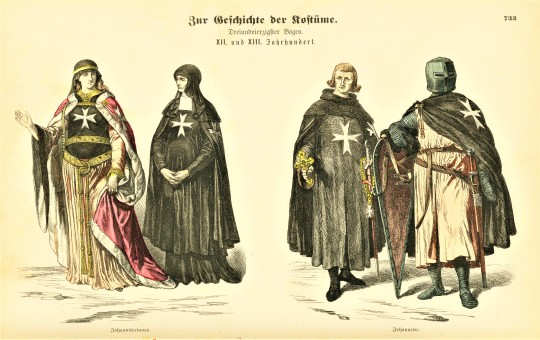




Fashion Friday: Liturgical Looks
This lapsed Catholic realizes that not all the above looks from Munich publishers Braun & Schneider’s Zur Geschichte der Kostüme are liturgical, strictly speaking, but I couldn’t resist the allure of an alliterative title. Church chic doesn’t quite have the same ring to it! These plates originally appeared as illustrations for the biweekly single-leaf publication Münchener Bilderbogen, published in Munich by Braun & Schneider from 1848-1898. The publishing firm also produced fifty annual volumes collecting the previous year’s output. The publication covered a wide range of topics including comic drawings of animals, humorous stories, cautionary tales, and illustrated fairy tales.
It is unclear when this volume of plates illustrating both historical and contemporary regional fashion trends was produced. The publishers started producing bound collections of their fashion plates as early as 1874, but it is likely this particular collection is from after 1898, as some of the plates are from the final annual Münchener Bilderbogen. The plates from Zur Geschichte der Kostüme were reproduced again in 1975 by Dover Publications under the title Historic Costume in Pictures, with Braun & Schneider credited as authors. As explained in a publisher’s note in that book, Dover decided to reproduce the plates in black and white because there is so much variation in color between the various remaining copies. This is confirmed by our own holdings: Special Collections has three copies of Zur Geschichte der Kostüme, all seemingly containing the same plates (though one is missing its index), and all lacking publication dates. Note the variations between the first plate in each volume:


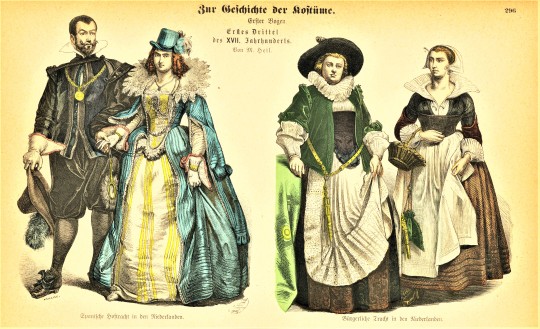
While German painter Louis Braun is credited as the lead artist for the collection in our catalog record, it is unclear if he contributed to any of these images, though the Crusaders (images 4 & 5) bear only the name “Cehric,” who the Library of Congress identifies as an engraver. Also unclear is whether Louis Braun is related to Kaspar Braun, of Braun & Schneider. The artist of images 6 & 7 is identified as M. Adamo, likely Max Adamo, brother of frequent Münchener Bilderbogen contributor Albert Adamo. A. Müller, (the artist of images 1-3 & 8) refers to the Düsseldorf-based painter Andreas Müller.
Check out our previous post on Zur Geschichte der Kostüme here.
Find more Fashion Friday posts here.
-Olivia, Special Collections graduate intern
#Fashion Friday#Zur Geschichte der Kostüme#Münchener Bilderbogen#History of Costume#Braun & Schneider#Kaspar Braun#Friedrich Schneider#Louis Braun#Cehric#Max Adamo#Albert Adamo#Andreas Müller#Munich#Munich publishers#Historical Fashion#Crusades#Monks#Liturgical Garb#olivia
88 notes
·
View notes
Text
all body parts in turn..
stretching leg muscles and buttock muscles these last months...
’’testing now for dementia’‘
during the night, last night they pressed my brain with laser beam (VERY PAINFUL) FOR HOURS – not the cranium as they have been doing…. the brain (you can feel)
They kill us with these endless torture ’’tests,’’ these wonderful brits..pure sadism for the sake of it….using nine Muslims to do their dirty work for them, killing us slowly, healthy, clever and talented people. (I am a teacher, painter and poet)
Their excuse,’we were messing with them illegally, we would have got jail.’
The three ‘doctors’ are jews. In Hitler’s time, in Bratislava, we gave life to the jews..we lost everything for helping them, saved them from what they are doing to us…their answer ‘that was then.’
SO WE DIE FOR ALL WE DID FOR THEM. They wonder why they are hated.
The lab was asked time and again, ‘why don’t you do the tests normally?’-
answer ‘no one would allow it.’
We are lab-rats for life, we have no Rights at all.
quote from the boss
’’I will use every hair of them. Hitler will be as nothing to what I will do. Destroy every avenue for life.’‘
We have never done anything wrong to the brits or anywhere else..As I was born after the war, I even asked Wiesenthal/Vienna to prove what I said was true. He did. After three months of searching…
‘Not known in any country.’
I still have the letter.
They still, after ten years, give the same file of lies to everyone, yet their country is filled with people who despise them, people they ‘allowed’ to enter the country.
They BROUGHT us, paid for our transport and begged us to settle here, POACHING our labour from Australia…TO BE USED FOR TORTURE FOR THEIR MAD HOSPITALS JUST AS HITLER DID. (all unwanted aliens were sent to mental hospitals)
This little known, but not new technology was given to this rogue-lab which has had previous warnings, by Kaspar Weinberger and Kissinger to use on us because we are ‘scum’ (quote)
The lab had begged for help to get them out of trouble breaking international law, (she films penises!) after secretly beaming our lives to New York h.research and setting off the alarms at SANTA MONICA.
N.Y. searched for the worst devil in the Sates, found in L.A…also a Jew who gave them a plan, to which they added, how to kill slowly and not be caught, tested in the States and sixty million for tests in Britain as it is all forbidden there. They were to put a porn film through all the world’s receivers, tv etc. with my head supplanted, make up a file, etc… another Jew, Ziegler, instructed them to publish every word I wrote and had written, painted..as they destroyed our lives totally…as the lab wives had been copying it from the screen and publishing it as their own.
I am almost laughing into my tears, my grandfather woke each morning knowing it might be his and his family’s last day, for helping jews….
so these jewish stories are really Hun’s and Uky’s. OURS…well, well, well.
They had gotten our names from a doctor who had said ‘odd’ things to me (a lecher) I was suffering from headaches so I would not go to the surgery anymore (I loved my ex. he loved us but couldn’t resist the ladies)
We were so vulnerable they decided they could use us as they wished, no one would care, and most wouldn’t even understand. I had been in the Women’s J unior Air Corps and my mother had been interpreter to the (russian) von Braun. I did understand about sound above hearing, radar and co-ordinates.
If I go teach abroad as I did in China, they tell the research (Hong Kong) of that country we are patients, pay them ten million and one of the lab follows me there and lets them use their stuff there,(phase out) they even follow me when I go on holiday! They even asked a Church of England priest to watch their film at the lab. I am a catholic, so its get the catholics now. Now there is no Soviet left, there is nowhere to run, anyway, why should we run?
Our Law Lord, along with most other lords, is jewish. We wouldn’t stand a chance against three corrupt lecherous psychiatrists and their wives, the lab workers. They no longer need allies they tell us. All has been forgotten.
To ensure that ‘it’ was so big they would be safe, they invited and paid research students to the lab to use us
for torture not permitted anywhere else in the world. Only the Russian woman immediately twigged and got out, then later the South African left, (oddly Mongolia, Japan and little Palestine twigged on too) shocked at the corruption in THIS country. The Germans played along with the Brits, equally brutally, robbing and torturing…and some of the others, Austria, Hungary, Ukraine, Pakistan, India, Serbia, Iraq, etc all on their machine now, were too slow to understand what was really going on.
At present they are pressing my heart again, the squeezing as well as being painful, makes the action sluggish, so it will just pack up soon.
Try telling your doctor that..
When they are told to correct what they have done, thousands and thousands in thefts, jobs destroyed, internal organs destroyed, their answer over tv etc is ’’sorry.’‘
The Pakistanis laugh at us, they wouldn’t dare do that to us…so much for being decent citizens.
0 notes
Photo
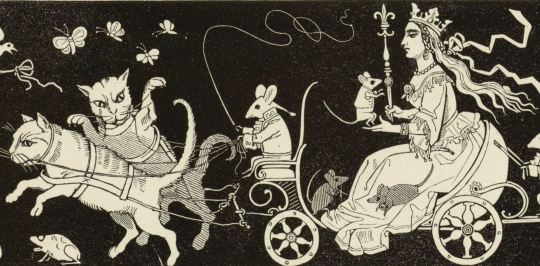
The magic lanterns (detail) by Kaspar Braun, c. 1843-1920.
#my future self#The magic lanterns#Kaspar Braun#1800s#1900s#19th century#20th century#illustration#book illustration#bookplate#animals#fairytale#art history#art detail#art#history
3K notes
·
View notes
Text
top 10 movies watched in FEBRUARY 2020
1. Jeanne Dielman, 23, Quai du Commerce 1080 Bruxelles (1975, Chantal Akerman)
2. Portrait of a Lady on Fire (2019, Céline Sciamma)
3. Blood Tea and Red String (2006, Christiane Cegavske)
4. The Nun (1966, Jacques Rivette)
5. Written on the Wind (1956, Douglas Sirk)
6. The Legend of Suram Fortress (1985, Sergei Parajanov)
7. The Blue Angel (1930, Josef von Sternberg)
8. Die Nibelungen: Siegfried (1924, Fritz Lang)
9. The Marriage of Maria Braun (1979, Rainer Werner Fassbinder)
10. The Enigma of Kaspar Hauser (1974, Werner Herzog)
#month#top 10#jeanne dielman#chantal akerman#portrait of a lady on fire#céline sciamma#blood tea and red string#the nun#jacques rivette#written on the wind#douglas sirk#the legend of suram fortress#sergei parajanov#the blue angel#josef von sternberg#die nibelungen#fritz lang#the marriage of maria braun#rainer werner fassbinder#the enigma of kaspar hauser#werner herzog
20 notes
·
View notes
Text
Martin Scorsese’s 125 favourite movies
The Infernal Cakewalk (1903)
Secrets of the Soul (1912)
The Four Horsemen of the Apocalypse (1921)
Nosferatu (1922)
Dr. Mabuse the Gambler (1922)
Metropolis (1927)
Napoleon (1927)
The Power and the Glory (1933)
It Happened One Night (1934)
Mr. Deeds Goes to Town (1936)
La Grande Illusion (1937)
Mr. Smith Goes to Washington (1939)
Stagecoach (1939)
The Roaring Twenties (1939)
The Rules Of The Game (1939)
Citizen Kane (1941)
How Green Was My Valley (1941)
Sullivan’s Travels (1941)
Cat People (1942)
Arsenic and Old Lace (1944)
Rome, Open City (1945)
Children Of Paradise (1945)
Duel in the Sun (1946)
Gilda (1946)
A Matter of Life and Death (1946)
Paisan (1946)
Beauty & The Beast (1946)
The Lady From Shanghai (1947)
T-Men (1947)
I Walk Alone (1947)
The Red Shoes (1948)
Germany Year Zero (1948)
Force of Evil (1948)
La Terra Trema (1948)
Macbeth (1948)
Raw Deal (1948)
Bicycle Thieves (1948)
Caught (1949)
The Third Man (1949)
Stromboli (1950)
The Flowers of St. Francis (1950)
Gun Crazy (1950)
Night and the City (1950)
An American in Paris (1951)
The River (1951)
Ace in the Hole (1951)
The Magic Box (1951)
The Bad and the Beautiful (1952)
Europa ’51 (1952)
Othello (1952)
Umberto D. (1952)
Ikiru (1952)
The Band Wagon (1953)
House of Wax (1953)
Julius Caesar (1953)
Pickup on South Street (1953)
Ugetsu (1953)
Tokyo Story (1953)
Dial M for Murder (1954)
Journey to Italy (1954)
Senso (1954)
Seven Samurai (1954)
Sansho the Bailiff (1954)
All that Heaven Allows (1955)
Kiss Me Deadly (1955)
The Searchers (1956)
Forty Guns (1957)
Sweet Smell of Success (1957)
Some Came Running (1958)
Touch of Evil (1958)
Vertigo (1958)
Ashes and Diamonds (1958)
Big Deal On Madonna Street (1958)
Shadows (1959)
The 400 Blows (1959)
Peeping Tom (1960)
Rocco and His Brothers (1960)
Shoot the Piano Player (1960)
Breathless (1960)
L’Avventura (1960)
The Hustler (1961)
One, Two, Three (1961)
Cape Fear (1962)
The Trial (1962)
Two Weeks in Another Town (1962)
Salvatore Giuliano (1962)
Il Sorpasso (1962)
America, America (1963)
Jason and the Argonauts (1963)
The Leopard (1963)
Shock Corridor (1963)
High and Low (1963)
8½ (1963)
The Fall of the Roman Empire (1964)
Band of Outsiders (1964)
Before the Revolution (1964)
The Rise of Louis XIV (1966)
Blow-Up (1966)
Weekend (1967)
Faces (1968)
2001: A Space Odyssey (1968)
Death by Hanging (1968)
Midnight Cowboy (1969)
The Butcher (1970)
M*A*S*H (1970)
The American Friend (1970)
Klute (1971)
McCabe & Mrs. Miller (1971)
The Merchant of Four Seasons (1971)
The Godfather (1972)
Aguirre, the Wrath of God (1972)
The Conversation (1974)
Ali: Fear Eats The Soul (1974)
The Enigma of Kaspar Hauser (1974)
The Messiah (1975)
Nashville (1975)
Kings of the Road (1976)
Apocalypse Now (1979)
The Marriage of Maria Braun (1979)
Health (1980)
Heaven’s Gate (1980)
Mishima (1985)
Born on the Fourth of July (1989)
Do the Right Thing (1989)
The Player (1992)
#martin scorsese#list#favourite movies#vertigo#2001 a space odyssey#heaven’s gate#apocalypse now#the godfather#klute#shock corridor#l’avventura#gun crazy#gilda#arsenic and old lace#how green was my valley#citizen kane#it happened one night#born on the fourth of july#metropolis
174 notes
·
View notes
Photo

now playing: Kaspar & Paul
0 notes
Note
Rip's backstory? Im gonna President's day this question, actually. Major's? Dok? Do you think Schrodinger is based (in universe) on a an actual Kid? (My Headcanon)
Whoa! Thanks for the questions! I’m going to break the answers up by character for length. I touched on some of these points in a past post, so I’ll expand on them. First up, Rip Van Winkle!
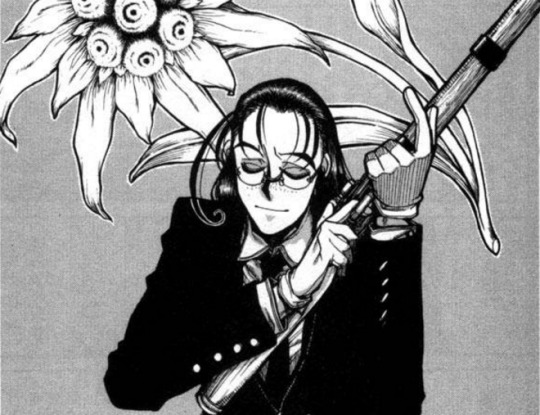
Rip seems to be Zorin’s opposite; she’s the ‘Eva Braun’ to the latter’s ‘Brunhilde’. Zorin appears to represent the more agrarian population, while Rip is more the urban-dwelling socialite. She seems more refined in her style of dress and love of opera, so I would imagine she comes from a higher social class, possibly the daughter of an officer. That or she’s putting on airs to make one think she’s from a more affluent background than she really is.
I think Rip was likely born around the Rhineland, given her moniker is both Dutch and a literary reference to Irving's Rip Van Winkle because:
The Rhineland is closer to Holland than any other part of Germany. While the German ‘Von’ is more common in names, the Dutch ‘Van’ makes its way in there too: example Ludwig Van Beethoven who was originally from Bonn, Germany. So she might be of Dutch descent to some degree, too?
Irving’s novel takes place in the Hudson Valley, which Life magazine in 1939 called “America’s Rhineland” because they are a bit geographically similar.
I think Rip was born and raised on propaganda. In Dawn, her hair is braided similarly to girls and women in the BMD. She likely joined as a preteen and was active in it until her late teens or until 21. The BMD indoctrinated young women and taught a very romanticized version of German folklore and tradition coupled with the National Socialist system. That’s probably what lends to Rip’s more silly, girlish, and romantic personality and outlook on the events in Hellsing. A lot of the BMD’s teaching also focused on the “self-sacrifice’’ women should make to further the cause of the party, which seems to match her sacrificing herself to further Millennium's goals to keep Alucard stuck at sea for a bit to launch their attack.
She likely voluntarily joined the Aufseherin, too. I think Rip (and Zorin to an extent in terms of sheer brutality and rural upbringing) is based on Irma Grese the most. Grese is described as being beautiful, immaculately dressed, and one of the most sadistic female guards. That description seems to fit Rip and her gleeful enjoyment of Mill’s actions.
Given her entrance in Hellsing: The Dawn (she’s K.O.’d like immediately) and moniker, I think Rip is out cold for pretty much the entirety of the Hellsing Raid and misses the rest of WW2. In Irving’s novel, Rip Van Winkle falls asleep for 20 years and misses the American Revolution. This leads me to think that Hellsing Rip is out for an extended period as well due to the karate chop from Alu’s coffin to the back of her head.
I think the hit also caused some extensive head trauma and forced the Doktor to work on her shortly after the raid. In the opening of Dawn, Millennium is experimenting on POW’s and only seems to be able to create ghouls, not the more advanced bootleg vampires, yet. I think Rip was one of the first, if not the original successful FREAK. I also believe she fell flat on her face and chipped her teeth after being knocked out, and Dok filed them into points, giving Rip her signature smile.
Due to her unconsciousness and missing parts of the war, I think Mill’s higher-ups (namely Major) gave her the moniker Rip Van Winkle as a joke.
I believe the wack to the head messed with Rip’s memory too, possibly giving her amnesia, and is one of the reasons why she’s so attached to Der Freischütz. I think she always enjoyed opera. Those with amnesia, while they might forget past events, loved ones, have been known to have their musical memory still intact. I think this is one of the reasons she’s so obsessed with the opera and strongly relates to it; it’s one of the strongest things she can remember and thus relates to it waaay too hard. (Wouldn’t feel bad for her. The whole aftermath of the Hellsing Raid is pure speculation on my part. Rip’s scarily loyal to Mill, so she’s terrible through and through.)
Her being called Rip Van Winkle showcases how her, and by extent all of Millennium, are stuck in the past and are resistant to change. Irving’s story is a cautionary tale about wasting your life away, and Mill, well, they waste their lives trying to get revenge/overcome the supernatural/prove their superiority.
Her catchphrase “Tinker tailor soldier sailor, my bullet punishes all without distinction” is a reference to the old ‘Tinker, Tailor’ game/nursery rhyme children used to use to identify who was “it” in a game of tag. I think it highlights how childish Rip is, she views shooting someone kin to playing deadly tag.
In the novel Tinker Tailor Soldier Spy, named after the same rhyme, British SIS agents track down a Soviet spy in their ranks. I think this also references how Rip got on the Eagle using British naval forces that betrayed the crown in return for vampirism.
I have no fucking idea where the hell she got the Jezail rifle from. They were really popular with Afghan troops, especially during the Anglo-Afghan war. I think it’s supposed to add insult to injury that she’s using a musket that devastated British forces in 1800′s before while also reinforcing how behind the times she is.
She seems to personally relate to Kaspar in Der Freischütz, who in the opera makes a deal with Samuel, an evil spirit/the devil known as Black Huntsman, for magic bullets. However Rip got her powers, I imagine it took her (with the help of Mill/Dok) summoning an evil spirit and making a deal with it that enabled her to shoot cursed bullets.
The fact that Rip and Zorin are a part of Mill highlights that they’re both highly effective soldiers. Their leadership roles are also one of the things that show how unorthodox Major is at running his organization. Women participated in military service, but it was very regimented because the Nazi’s were, in a word, conservative. Women served alongside men, but they could never give their male soldiers orders. Both Rip and Zorin are officers with troops under their command, so they must be good at what they do, even if Rip is a bit of a ditz at times.
Rip is the only one who is scared shitless of Alucard when she first sees him. She seems slightly more ‘realistic’ about her capabilities, but goes through with being bait, cementing her extreme loyalty to Mill’s cause. However, the way she talks about Alucard makes me wonder if she’s aware that they are truly fighting the actual Dracula. Rip seems to believe Alucard IS Samuel to some degree(???). The way Major builds up this idea in her flashback leads me to believe Major isn’t 100% truthful about what exactly Mill is fighting or their end goal (even to higher-ranking officers) and is fine letting his soldiers believe in whatever gets them to do what he wants (read: die horribly).
#asks#hellsing#Rip van Winkle#Hellsing Ultimate#Headcanon#analysis#manga#westenra1897#long post#working on the rest#couldn't shut up about winks#millennium
78 notes
·
View notes
Photo
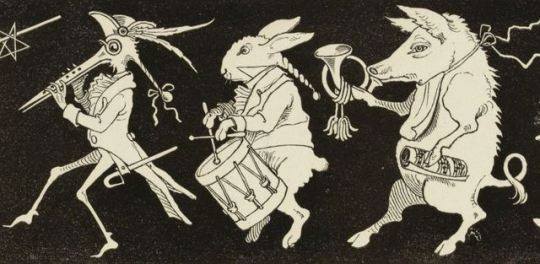
The magic lanterns (detail) by Kaspar Braun, c. 1843-1920
26 notes
·
View notes
Video
Fliegende Blätter / Band CXIV / Bild 078 by Michael Studt
Via Flickr:
Fliegende Blätter / Wochenschrift Band 114 (2892 - 2917) Verlag: Braun & Schneider (München / Deutschland; 1901) ex libris MTP
#Buch#book#livre#Wochenschrift#Magazin#Kunst#art#Fliegende Blätter#Humor#Satire#Bildergeschichten#comic#vintage#Braun und Schneider Verlag#Wilhelm Busch#Ferdinand Barth#Hermann Vogel#Gustav Adolf Closs#Hans Kaufmann#Kaspar Kögler#Franz Kreuzer#Adolf Oberländer#Franz Graf von Pocci#Carl Reinhardt#Carl Spitzweg#Emil Reinicke#René Reinicke#Hermann Stockmann#Eugen Croissant#Gustav Traub
0 notes
Photo
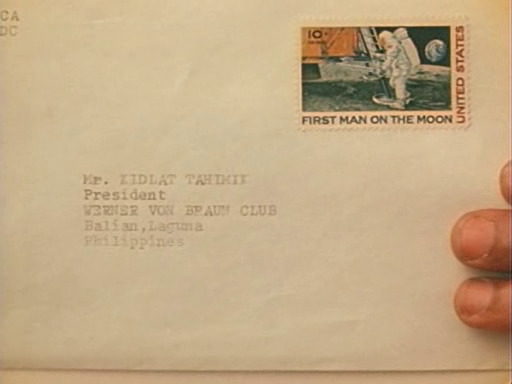
Perfumed Nightmare (Kidlat Tahimik, 1977)
Movies don’t come much more independent than Perfumed Nightmare, filmed on a budget of about $10,000, with Kidlat Tahimik (real name Eric de Guia) serving as writer, director, producer, editor, and star, in addition to acting as cinematographer for a lot of the scenes he wasn’t in. Since the picture was filmed without live sound he also voices multiple parts. It’s a mixture of documentary and fiction narrated by a character named Kidlat Tahimik, a naive villager in the Philippines who idolizes America, particularly its space program, and runs the local Werner Von Braun fan club. An American chewing gum magnate takes Kidlat to Paris to work for him, where Kidlat becomes disillusioned with progress, technology, and colonial influence.
The real Kidlat/Eric, upon completing his undergraduate studies in the Philippines, went to the University of Pennslvania’s Wharton School of Business and got an MBA, followed by working as an economist in France for a few years. Sometime during his stay in Europe he met Werner Herzog, who cast him in a bit part in 1974′s The Enigma of Kaspar Hauser and encouraged him to make a film of his own. Perfumed Nightmare ended up winning the International Critics’ Prize at the Berlin Film Festival and being championed by Sontag and Coppola.
8 notes
·
View notes
Photo

Bekannt als Meister Eder Gustl Bayrhammer - mehr als ein Vorzeigebayer 12.02.2022, 14:40 Uhr Vom Dorfrichter im "Zerbrochenen Krug" bis zum Tatort-Kommissar: Gustl Bayrhammer ist in so einige Rollen geschlüpft. Besonders geschätzt wird der Schauspieler von Groß und Klein als Meister Eder in der Kultserie "Pumuckl". Nun jährt sich sein Geburtstag zum 100. Mal. Für viele ist Gustl Bayrhammer der Meister Eder, in dessen Schreinerei ein Kobold seine Späße treibt. Bis heute haben Fans sein gemütliches Bairisch im Ohr, sein Granteln, sein herzhaftes Lachen in den Hörspielen und der Kultserie "Pumuckl". Doch der Schauspieler aus Krailling bei München spielte noch viele andere Theater- und Fernsehrollen. Unvergessen seine Auftritte als barocker Himmelspförtner in "Der Brandner Kaspar und das ewig' Leben" am Bayerischen Staatsschauspiel mit Kollegen wie Toni Berger und Fritz Strassner, festgehalten in einer legendären TV-Aufzeichnung. Nun wird wieder an den Volksschauspieler erinnert, der diesen Samstag seinen 100. Geburtstag gefeiert hätte. Bayrhammer begeisterte im Münchner Tatort als Kommissar Veigl. (Foto: picture-alliance / KPA Copyright) Er habe "die Grantler fröhlich und die Bedächtigen lebendig gemacht", sagte der ehemalige Münchner Opernintendant August Everding mal über Bayrhammer. Dieser hatte schon als kleiner Bub von der Schauspielerei geträumt. "Das Schönste war für mich immer, schon daheim und in der Schule, wenn ich d'Leut zum Lachen bracht hab", sagte er mal der "Süddeutschen Zeitung". "A Kasperl, der zum Theater kommen ist." Doch das sollte noch dauern. Sein Vater Max, selbst erfolgreicher Hofschauspieler, ließ den Sohn die Mittlere Reife machen und schickte ihn auf die Kaufmannsschule in München. Erst nach dem Militärdienst wurde Bayrhammers Traum wahr. Am Berliner Schillertheater bei Heinrich George begann er noch während des Zweiten Weltkrieges eine Schauspielausbildung, die er 1944 mit Anfang 20 abschloss. Vehemente Stimme gegen Rechtsextremismus Eine Jugend im Nationalsozialismus - Erfahrungen, die Bayrhammer später vehement gegen rechte Tendenzen in der Gesellschaft wettern ließen. So im Jahr 1992, in dem eine schlimme Folge rechtsextremer Gewalt und Anschläge vor allem auf Menschen mit Migrationshintergrund Deutschland erschütterte. "Meine Angst, dass diese ganze braune Scheiße wiederkommt, und zwar vorbereitet von jetzigen sogenannten Demokraten", sagte er damals dem Bayerischen Rundfunk (BR). "Und das ist für mich der Herbst 1992 in Deutschland. Wehret den Anfängen." Energisch und leidenschaftlich war Bayrhammer auch auf der Bühne. Kein Mann der leisen Töne und nicht gerade der jugendliche Held: "Stimmlich lag ich immer zu tief", sagte er mal in einem Interview. Der Schauspieler reüssierte dennoch, auch wenn es dauerte. 1966 hatte er eine Schicksalsbegegnung mit der legendären Therese Giehse: So begeistert war die Schauspielerin, dass sie ihn bei den Münchner Kammerspielen unterbrachte. "Bayerisch ist nicht nur Kasperltheater" Bayrhammers Repertoire war weitgespannt: Es umfasste unter anderem Werke von Ödön von Horváth, Friedrich Schiller, William Shakespeare und besonders gerne von Ludwig Thoma, den ihm sein Vater als den "bayerischen Shakespeare" ans Herz gelegt hatte. Im Fernsehen spielte er etwa in der ZDF-Serie "Königlich Bayerisches Amtsgericht", im "Komödienstadel" oder als Kommissar Veigl im Münchner "Tatort". Ein Vorzeigebayer? Auf keinen Fall. Das war Bayrhammer verhasst, ebenso wie das außerhalb des Freistaats gern gepflegte "Seppl-Image". Immer wieder wird er mit der Aussage zitiert, das Volk sei nicht tümlich. "Ich bin ein Bayer, ich weiß das. Aber ich versuche, das Klischeebild des Bayern immer zu korrigieren", sagte er mal dem BR. Ein andermal befand er: "Bayerisch ist nicht nur Kasperltheater, es kann sehr dramatisch sein". Auch im Komödienstadel war Bayrhammer zu sehen. (Foto: picture alliance / United Archives) Die Rolle des Dorfrichters Adam in "Der zerbrochene Krug" am Münchner Volkstheater kam ihm da gerade recht - Heinrich von Kleists Lustspiel ins Bairische übertragen, gesetzt in fünffüßige Jamben. "Das war zwar furchtbar schwer zu lernen", erzählte er 1984 der Deutschen Welle. Aber der Rhythmus, die Musik! Reinstes Volkstheater, so Bayrhammer. "Ein bisschen liebe ich das Ganze sehr!" Überhaupt liebte er die Schauspielerei so sehr, dass er nach einem Herzinfarkt 1986 weiter Filme und Serien drehte und Theater spielte. Am 24. April 1993 dann erneut ein Herzinfarkt, zu Hause in Krailling, wo er mit seiner Frau Ingrid wohnte. Ein rascher Tod riss Bayrhammer aus einem Leben, dass er sehr genossen hatte, wie er kurz vor seinem 70. Geburtstag resümiert hatte: "Ich bin wunschlos glücklich, es war alles schön, ich möchte keinen Tag missen".
0 notes
Photo





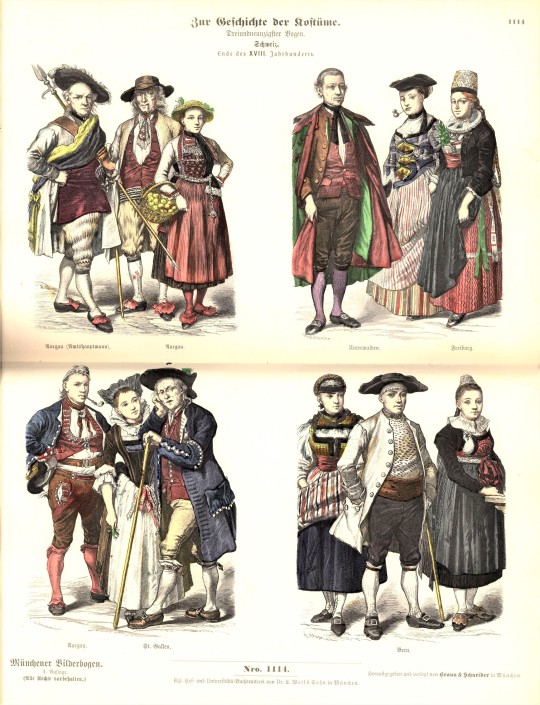
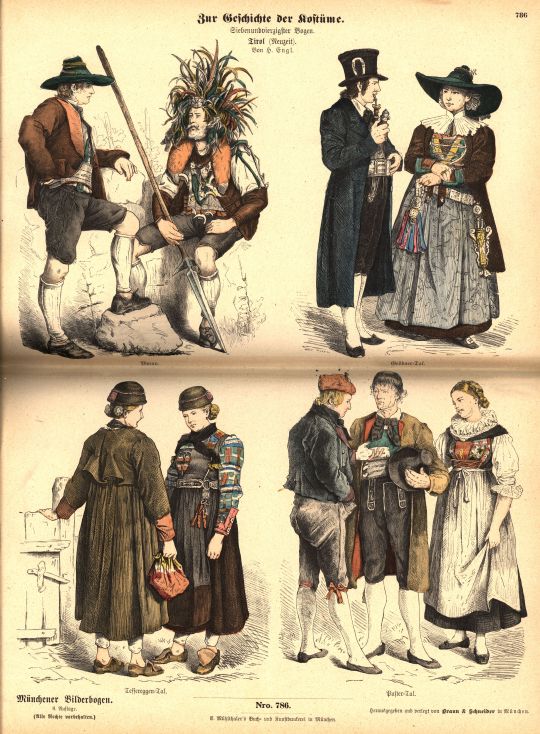


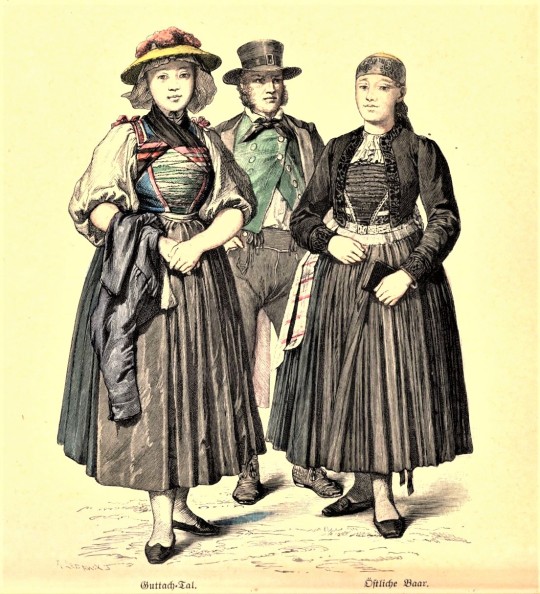
Fashion Friday des Volkes
This week we have a selection of plates from Zur Geschichte der Kostüme (or “History of Costume” for you non-Teutonophiles) printed by Braun & Schneider in Munich, ca. 1895. Wood engraver and painter Kaspar Braun and book dealer and illustrator Friedrich Schneider founded the firm in 1845 to publish their satirical magazine, Fliegende Blätter (“Flying Leaves” or “Loose Sheets”).
Originally published as individual plates for Braun & Schneider’s biweekly magazine Münchener Bilderbogen (1848-1898), each plate contains four images, and each image features two to four (or more) figures. With approximately 200 folded color plates covering costume design from antiquity to contemporary folk fashions from a variety of social classes around the globe, from peasant to king, Zur Geschichte der Kostüme is an excellent resource for costume designers, milliners, fashion historians, or general lovers of historical fit!
Published at a time when regional folk styles had yet to be supplanted by a homogenized European fashion sensibility, Zur Geschichte der Kostüme is particularly strong in chronicling traditional folk dress.
Presented here in order are examples primarily from Central Europe (with the exception of Brittany).
1 & 2. Bayern (Bavaria)
3. Norddeutschland (Northern Germany)
4. Baden (Baden-Württemberg, Southwest Germany)
5. Holland
6. Switzerland
7. Tyrolean Alps
8. Bretagne (Brittany)
9. Dalmatia (Croatia)
10.Detail from the Baden plate
View more Fashion Friday Posts here and keep an eye out for more plates from Bruan & Scheider’s Zur Geschichte der Kostüme in the future, or stop by Special Collections and take a look!
-Olivia, Special Collections Graduate Intern
#Fashion Friday#costumes#fashions#folk fashion#historical costumes#Zur Geschichte der Kostüme#Kaspar Braun#Friedrich Schneider#Braun & Schneider#olivia
106 notes
·
View notes
Photo
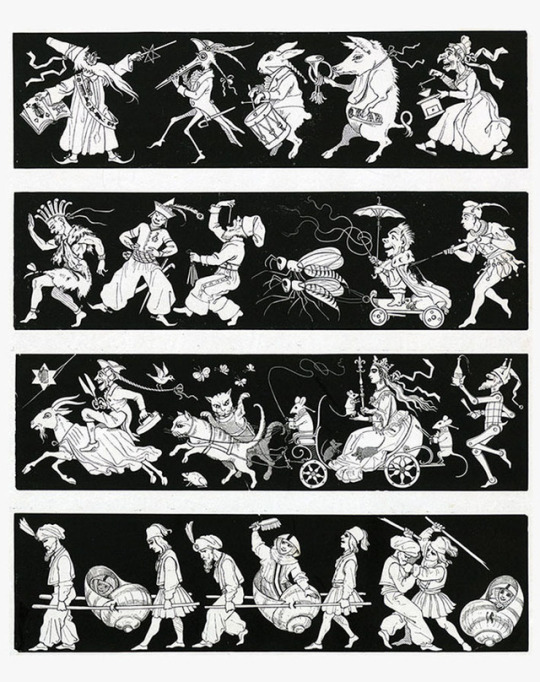
Kaspar Braun, Magical pictures for a “Laterna magica”, 1853. Wood cut, from Münchener Bilderbogen, Germany. Universität Regensburg
152 notes
·
View notes
Photo

Sicherlich habt ihr gestern den Nikolaus vermisst, der bei vielen wegen Corona nicht persönlich erschienen ist. Ganz tief im Archiv hat das historische Museum diese Aufnahme gefunden, die schon über 100 Jahre alt ist. Der Belzemärdl, wie der Nikolaus hier in der Gegend genannt wird, unterwegs in einem verschneiten Hofgarten. Foto des winterlichen Hofgartens aus dem Stadtarchiv Bayreuth. Pelzmärtl aus dem Bilderbogen "Vom bösen Kater und vom Pelzmärtel" (https://www.europeana.eu/item/08547/sgml_eu_php_obj_gr017934) von Reinhardt, Carl August (1818-1877) (Zeichner); Kaspar Braun und Friedrich Schneider in München (Verlag); Dr. C. Wolf und Sohn in München (Druckerei). Aufbewahrungsort: Stadtgeschichtliches Museum Leipzig - http://museum.zib.de/sgml/eu.php?obj=gr017934. Lizenz: CC BY-NC-SA - http://creativecommons.org/licenses/by-nc-sa/4.0/ 📷©️: @historisches_museum_bayreuth #travelcultured #winterland #prettycitytravel #artemondo_ #ShareGermany #15cities #weltderwilhelmine #markgrafenkultur #bayreuth #nikolaus #dreamnowtravellater #bucketlist #vivoartworld #traveling_arte #culturetrip #wonderful_places #kings_villages #geschichte #visitgermany #belzemärdl #mustdotravels #inspiringplace #visitfranconia #lesphotographes #discovergermanyfromhome #fever_art #kings_luxury #beautifulplace #europe_perfection #citybestviews (hier: Bayreuth Hofgarten) https://www.instagram.com/p/CIffGkVhWTc/?igshid=1nlwnvdsbwinr
#travelcultured#winterland#prettycitytravel#artemondo_#sharegermany#15cities#weltderwilhelmine#markgrafenkultur#bayreuth#nikolaus#dreamnowtravellater#bucketlist#vivoartworld#traveling_arte#culturetrip#wonderful_places#kings_villages#geschichte#visitgermany#belzemärdl#mustdotravels#inspiringplace#visitfranconia#lesphotographes#discovergermanyfromhome#fever_art#kings_luxury#beautifulplace#europe_perfection#citybestviews
0 notes
Photo

Fliegende Blatter, revue humoristique, satyrique allemande, on y trouve également des caricatures. Publiée de 1845 à 1944, certains illustrateurs célèbres : Kaspar Braun, Wilhem Busch, René Reinicke, Carl Spitzberg etc.. #fliegendeblätter #caricature #carlspitzberg #kasparbraun #renereinicke (à Librairie Abraxas-Libris) https://www.instagram.com/p/B266NM5HeuA/?igshid=csnl9xcdrfwt
0 notes
Photo

Festivāla “Via Baltca” programmā iekļautas arī četras bezmaksas jaunākās latviešu kino filmas par valsts neatkarībai nozīmīgām personībām un notikumiem: spēlfilma “Paradīze '89” par četru meiteņu vasaras brīvdienām laikā, kad televīzijā sludina ārkārtas stāvokli valstī un notiek ”Baltijas ceļš”, dokumentālās filmas par daudzu neatkarības atgūšanas laikam nozīmīgu un populāru dziesmu autoru Mārtiņu Braunu, tikko pabeigtā Dzintras Gekas dokumentālā filma par izcilu latviešu mākslas personību Ilmāru Blumbergu un Latvijas, Francijas un Ukrainas kopražojuma filma “Dubultā dzīve. Sekss un PSRS”, kas stāsta par to, ka, lai arī Padomju savienībā drīkstēja mīlēt tikai vadoni un partiju, bērni dzima, taču sekss praktiski bija pasludināts par "neesošu".
Ieeja uz filmu seansiem ir bez maksas, bet ierobežotā vietu skaita dēļ, lūdzam izņemt bezmaksas ieejas kartes Liepājas “Jauniešu mājā”, Kungu ielā 24 (ieeja no Bāriņu ielas). Liepājas “Jauniešu māja” ir atvērta katru darbadienu un sestdienās no plkst. 14.00 līdz 20.00.
Ceturtdien, 22. augustā, plkst. 17.00 Liepājas “Jauniešu mājā”
Kamēr tu šo dzīvi spēlē
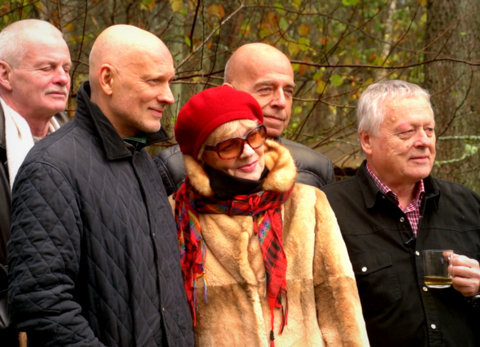
Dokumentālā filma, garums – 57 min, režisors un producents – Arvīds Krievs, operators – Jānis Vingris, filmu studija “Kaupo Filma”, 2018
Filma vēsta par komponistu Mārtiņu Braunu – spilgtu personību un talantīgu mūziķi, kurš ir absolūts līderis filmu skaita ziņā starp visiem komponistiem, kas rakstījuši mūziku Latvijas filmām, – viņa filmogrāfijā var saskaitīt vairāk nekā 160 nosaukumu. Mārtiņš Brauns un filmas režisors Arvīds Krievs ir seni kolēģi – jau kopš 70. gadu sākuma. Mārtiņa Brauna pirmā kinomūzika rakstīta A. Krieva dokumentālajām filmām “Pūra lāde” (1974) un “Daba” (1976), vēlāk sekoja arī “Aveņu vīns” (1984), “Fotogrāfija ar sievieti un mežakuili” un daudzas citas.
--
Ceturtdien, 22. augustā, plkst. 19.00 Liepājas “Jauniešu mājā”
Ilmārs Blumbergs

Dokumentālā filma, garums – 56 min, režisore un scenārija autore – Dzintra Geka, līdzautore – Gundega Repše, filmu studija “Studija SB”, 2019
Ilmārs Blumbergs (1943-2016) Latvijas mākslā ir hrestomātiski pierādāms jēdziens, ja analizē viņa radīto scenogrāfijā, plakātu mākslā, glezniecībā un multimedijos. Taču personība –Blumbergs – ir mainīga un netverama matērija, kas visam viņa radītajam piešķir virsvērtību, brīnumainību, intimitāti, ko viņa mākslas un pasaules uztveres izzinātājs pazīst itin kā no aizlaikiem, taču nespēj kataloģizēt, iegrāmatot un, par laimi, arī patērēt.
--
Ceturtdien, 29. augustā, plkst. 17.00 Liepājas “Jauniešu mājā”
Paradīze '89

Spēlfilma, garums – 89 min, režisore un scenārija autore – Madara Dišlere, lomās – Līva Ločmele, Mantas Bendžius, Magda Lote Auziņa, Marta Ģertrūde Auzāne, Evelīna Ozola, Guna Zariņa, Nauris Puntulis, Kaspars Gods, Baiba Broka un citi, filmu studija Tasse Film, 2018
Rīdzinieces Paula un Laurēns vasaras brīvlaikā ierodas pie māsīcām Maijas un Lindas, kuras dzīvo idilliskā mazpilsētā. Pieaugušo nepieskatītā četru meiteņu komanda bauda brīvību, iztēlojoties, kā ir būt pieaugušām. Maija, idealizējot savu reti klātesošo mammu Ievu un iejūtoties mātes lomā, uzņemas meiteņu sadzīves vadīšanu. Paulai pēc telefona sarunas ar savu māti rodas sajūta, ka arī viņas vecāki šķiras, – viņa ir apjukusi. Spriedzi kāpina televīzijas ziņas par satraucošiem notikumiem, un meiteņu attiecības kļūst saspīlētas. Paulā aug kareivīgums, un viņa nolemj rīkoties, cerot, ja Latvija atgūs brīvību, jaunā situācija izvērtīsies par labu visiem – māsīcu māte Ieva atgriezīsies pie savām meitām, nejaušam paziņam, lietuvietim Jonasam nebūs jāslēpjas no iesaukuma padomju armijā un viņa ar Laurēnu tiks mājās un saglābs brūkošo ģimeni.
--
Ceturtdien, 29. augustā, plkst. 19.00 Liepājas “Jauniešu mājā”
Dubultā dzīve. Sekss un PSRS

Dokumentālā filma, garums – 55 min, režisore – Ināra Kolmane, montāžas režisors – Katja Šelli, filmu studija “Deviņi”, Latvijas, Francijas un Ukrainas kopražojums, 2018
Padomju Savienībā seksa tēma pamatā bija aizliegta, jo sekss kā personiskās brīvības izpausme bija viens no valdošā totalitārisma slēptajiem ienaidniekiem. Protams, bērni dzima, taču sekss praktiski bija pasludināts par "neesošu". Drīkstēja mīlēt tikai vadoni un partiju. Filma ir stāsts par antiseksuālu eksperimentu, kurš par spīti savai varenībai un plašumam, kam tika pakļauta viena piektdaļa visas pasaules sauszemes teritorijas, cieta krahu, tādējādi pierādot, ka neviena diktatūra, neviena politiskā iekārta nespēj aizliegt mīlēt.
--
Plašāku festivāla programmu meklē: viacultura.lv/viabaltica
0 notes